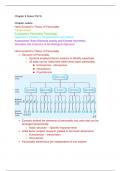Class notes
Need help?
- Course
- PSYS 317
- Institution
- Ball State University
Provides in-depth reasoning behind the theories of personality and how it evolved. It also goes into detail on extroverts vs. introverts, neuroticism, and psychoticism. You will also see in the evolution section inherited tendencies, the natural selection theory, and anxiety and social exclusion. T...
[Show more]



